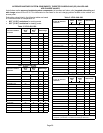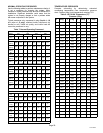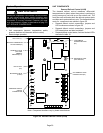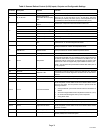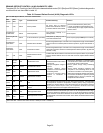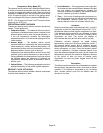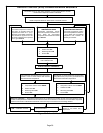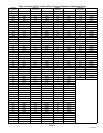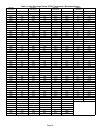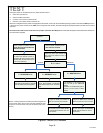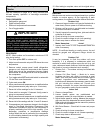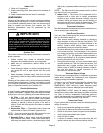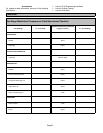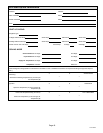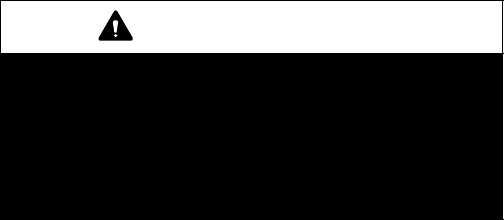
Page 41
XP16 SERIES
Indoor Coil
1. Clean coil if necessary.
2. Check connecting lines, joints and coil for evidence of
oil leaks.
3. Check condensate line and clean if necessary.
HOMEOWNER
Cleaning of the outdoor unit’s coil should be performed by
a trained service technician. Contact your dealer and set
up a schedule (preferably twice a year, but at least once a
year) to inspect and service your outdoor unit. The
following maintenance may be performed by the
homeowner.
IMPORTANT
Sprinklers and soaker hoses should not be installed
where they could cause prolonged exposure to the
outdoor unit by treated water. Prolonged exposure of the
unit to treated water (i.e., sprinkler systems, soakers,
waste water, etc.) will corrode the surface of steel and
aluminum parts and diminish performance and longevity
of the unit.
Outdoor Coil
The outdoor unit must be properly maintained to ensure its
proper operation.
S Please contact your dealer to schedule proper
inspection and maintenance for your equipment.
S Make sure no obstructions restrict airflow to the
outdoor unit.
S Grass clippings, leaves, or shrubs crowding the unit
can cause the unit to work harder and use more
energy.
S Keep shrubbery trimmed away from the unit and
periodically check for debris which collects around the
unit.
Cleaning of the outdoor unit’s coil should be performed by
a trained service technician. Contact your dealer and set
up a schedule (preferably twice a year, but at least once a
year) to inspect and service your outdoor unit.
Routine Maintenance
In order to ensure peak performance, your system must be
properly maintained. Clogged filters and blocked airflow
prevent your unit from operating at its most efficient level.
1. Air Filter Ċ Ask your Lennox dealer to show you
where your indoor unit’s filter is located. It will be either
at the indoor unit (installed internal or external to the
cabinet) or behind a return air grille in the wall or
ceiling. Check the filter monthly and clean or replace
it as needed.
2. Disposable Filter Ċ Disposable filters should be
replaced with a filter of the same type and size.
NOTE Ċ If you are unsure about the filter required for your
system, call your Lennox dealer for assistance.
3. Reusable Filter Ċ Many indoor units are equipped
with reusable foam filters. Clean foam filters with a
mild soap and water solution; rinse thoroughly; allow
filter to dry completely before returning it to the unit or
grille.
NOTE Ċ The filter and all access panels must be in place
any time the unit is in operation.
4. Indoor Unit Ċ The indoor unit’s evaporator coil is
equipped with a drain pan to collect condensate
formed as your system removes humidity from the
inside air. Have your dealer show you the location of
the drain line and how to check for obstructions. (This
would also apply to an auxiliary drain, if installed.)
Thermostat Operation
See the thermostat homeowner manual for instructions on
how to operate your thermostat.
Heat Pump Operation
Your new Lennox heat pump has several characteristics
that you should be aware of:
S Heat pumps satisfy heating demand by delivering
large amounts of warm air into the living space. This
is quite different from gas- or oil-fired furnaces or an
electric furnace which deliver lower volumes of
considerably hotter air to heat the space.
S Do not be alarmed if you notice frost on the outdoor coil
in the winter months. Frost develops on the outdoor
coil during the heating cycle when temperatures are
below 45F (7C). An electronic control activates a
defrost cycle lasting 5 to 15 minutes at preset intervals
to clear the outdoor coil of the frost.
S During the defrost cycle, you may notice steam rising
from the outdoor unit. This is a normal occurrence. The
thermostat may engage auxiliary heat during the
defrost cycle to satisfy a heating demand; however,
the unit will return to normal operation at the
conclusion of the defrost cycle.
Extended Power Outage
The heat pump is equipped with a compressor crankcase
heater which protects the compressor from refrigerant
slugging during cold weather operation.
If power to your unit has been interrupted for several hours
or more, set the room thermostat selector to the
EMERGENCY HEAT setting to obtain temporary heat
without the risk of serious damage to the heat pump.
In EMERGENCY HEAT mode, all heating demand is
satisfied by auxiliary heat; heat pump operation is locked
out. After a six-hour compressor crankcase warm-up
period, the thermostat can be switched to the HEAT setting
and normal heat pump operation may resume.
Preservice Check
If your system fails to operate, check the following before
calling for service:
S Verify room thermostat settings are correct.
S Verify that all electrical disconnect switches are ON.
S Check for any blown fuses or tripped circuit breakers.
S Verify unit access panels are in place.
S Verify air filter is clean.
S If service is needed, locate and write down the unit
model number and have it handy before calling.



